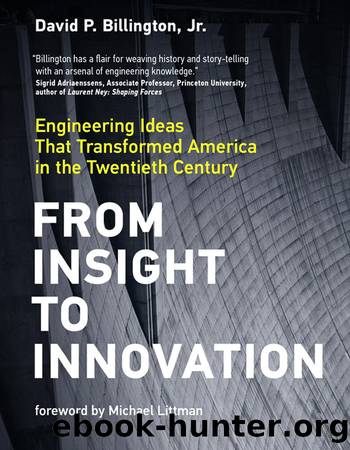From Insight to Innovation by David P. Billington Jr

Author:David P. Billington, Jr. [Billington, David]
Language: eng
Format: epub
Tags: Engineering; New Deal; Information Revolution; Frank Crowe; Colorado Compact; Hoover Dam; Tennessee Valley Authority; TVA; nuclear power; David Lilienthal; Franklin Roosevelt; Arthur Morgan; public utilities; Highways; Skyscrapers; interstate highway; civil engineering; nuclear engineering; computer engineering; mechanical engineering; aerospace engineering; Fazlur Khan; machines; Admiral Rickover; Nuclear energy; Atomic Bomb; Hyman Rickover; fusion; Jet Engine; Rocket; Robert Goddard; NASA; Frank Whittle; Moon Landing; Apollo Program; Bardeen; Transistor; Silicon; Silicon Valley; Solid-State Physics; Jack Kilby; Robert Noyce; Microchip; Gordon Moore; Fairchild Semiconductor; Intel; Integrated Circuit; Computer; Internet; Steve Jobs; Steve Wozniak; Apple Computer; Microsoft; Bill Gates
ISBN: 9780262044301
Publisher: MIT Press
Published: 2020-10-23T00:00:00+00:00
Figure 7.7
First integrated circuit produced by Fairchild Semiconductor, enlarged from its actual size of 0.125 inch in diameter (3.175 mm). Courtesy of ON Semiconductor, formerly Fairchild Semiconductor.
Kilby envisioned and demonstrated an entire circuit made of a single semiconductor. Noyce had a new method of interconnection, the planar process, with which he realized he could interconnect and manufacture an entire circuit on a chip. Combining the insights of Kilby and Noyce produced a new device, the integrated circuit, or microchip. Discoveries in quantum physics had suggested to the researchers at Bell Labs that a solid-state triode was possible. The transistor came from having an engineering objective, prior advances in semiconductor refining, and new scientific research. The integrated circuit combined an engineering insight, the use of a single material, with another engineering insight, the planar process. To innovate, Kilby and Noyce had to know the physics related to semiconductors, but they had to discover no new science in order to invent the microchip. The discrete transistor approached a barrier to its miniaturization after only a decade. The microchip removed the barrier and eventually became the basic component of electronics.
Like the transistor innovators, Kilby and Noyce had different personalities that influenced their approach to innovation. Kilby set aside time to read quietly. When he felt that he had perspective, he devoted himself intensely to solving a problem. Noyce was constantly in motion, often pursuing many ideas at once. He allowed insights to well up from his imagination, often in the middle of the night. However, Kilby spoke for both of them in observing: âA lot of solutions fail because theyâre solving the wrong problem.â26 From different starting points, Kilby and Noyce each identified a right problem and then contributed to its solution.
Texas Instruments came to recognize that the planar process was the best way to manufacture integrated circuits, and the firm licensed the process from Fairchild Semiconductor. But at first the two firms challenged each otherâs patent claims to the underlying ideas behind the microchip. Drafted quickly, the Kilby patent in February 1959 did not refer in as much detail to how to make the circuit, and in April 1961, the U.S. Patent Office awarded the patent to Fairchild, which had filed a rival claim on July 30, 1959, specifying the planar process. Texas Instruments appealed the decision, on the grounds that Kilby had conceived the monolithic idea earlier, and in February 1967 a higher body, the Board of Patent Interferences, ruled in favor of Kilby and the Texas firm. The U.S. Court of Customs and Patent Appeals then upheld the Fairchild claim, and the U.S. Supreme Court refused to hear the case in 1970. In 1966, however, the two companies agreed to cross-license their patents. By then, the microchip was too valuable for either company to depend on the uncertain outcome of litigation.27
Download
This site does not store any files on its server. We only index and link to content provided by other sites. Please contact the content providers to delete copyright contents if any and email us, we'll remove relevant links or contents immediately.
Whiskies Galore by Ian Buxton(40332)
Introduction to Aircraft Design (Cambridge Aerospace Series) by John P. Fielding(32338)
Small Unmanned Fixed-wing Aircraft Design by Andrew J. Keane Andras Sobester James P. Scanlan & András Sóbester & James P. Scanlan(32141)
Aircraft Design of WWII: A Sketchbook by Lockheed Aircraft Corporation(31772)
Craft Beer for the Homebrewer by Michael Agnew(17446)
Turbulence by E. J. Noyes(7039)
The Complete Stick Figure Physics Tutorials by Allen Sarah(6638)
The Institute by Stephen King(6259)
Kaplan MCAT General Chemistry Review by Kaplan(6054)
The Thirst by Nesbo Jo(5785)
Bad Blood by John Carreyrou(5769)
Learning SQL by Alan Beaulieu(5412)
Weapons of Math Destruction by Cathy O'Neil(5037)
Permanent Record by Edward Snowden(4998)
Man-made Catastrophes and Risk Information Concealment by Dmitry Chernov & Didier Sornette(4736)
iGen by Jean M. Twenge(4702)
Navigation and Map Reading by K Andrew(4553)
Digital Minimalism by Cal Newport;(4542)
Life 3.0: Being Human in the Age of Artificial Intelligence by Tegmark Max(4507)
